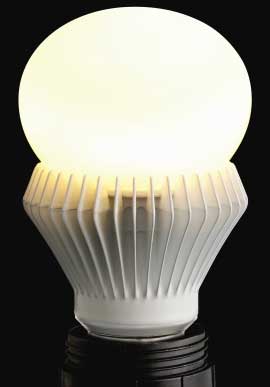
Cree LED maker is gunning for the demise of the 60-watt incandescent bulb with a demonstration LED bulb that’s energy efficient and disperses light in all directions.
The company today introduced a dimmable LED bulb, which it expects to get EnergyStar certification in the fall. Today’s date coincides with the day 131 years ago when Thomas Edison received a key patent for incandescent bulbs.
Cree makes components that go into an LED light fixture, notably the LEDs’ light sources themselves, and some light modules themselves. It has not yet decided how it will bring this demonstration 60-watt incandescent replacement to market, said Cree’s vice president of marketing, Greg Merritt. Likely paths are through a retailer, other bulb manufacturer, or selling the bulbs themselves.
Pricing has not yet been established but it’s meant to be a mass-market product, he added. Cree supplies LED light sources to GE and sells a down light for recessed cans at Home Depot. “It is meant to be relatively low cost–this is not one of those unaffordable demonstration projects. Part of the design criteria is to be very energy efficient, very high quality, and low cost.”
The bulb will give off over 800 lumens of light and consume less than 10 watts, making it significantly more energy efficient when measured on lumens per watt than an EnergyStar compact florescent bulb. The Cree LED is also rated to last over 25,000 hours, compared to 8,000 for a CFL.
Many LED bulbs now available are “snowcone” type bulbs which give off light on the top half of the bulb. Cree is seeking to make an “omnidirectional” bulb with a novel design that uses a remote phosphor and different type of heat sink.
The phosphor is the component that changes blue light from LEDs to pleasing white light. In Cree’s bulb, the phosphor is placed on a globe surrounding the actual light source. Outside of that phosphor is a white glass bulb, making the Cree light look more like a typical incandescent. The heat sink is a set of aluminium ridges that draw heat away from the LED light source. The colour rendering index, a measurement of light quality, will be over 90 and the temperature will white at 2700 Kelvin, Merritt said.
Cree is submitting the demonstration bulb to the EnergyStar program for testing, which is expected to be completed in the fall. The company is up against GE, Philips, Osram Sylvania, Lighting Sciences Group, Lemnis Lighting, and many others which are bringing out LED bulbs bright enough to replace 40-watt or 60-watt incandescent bulbs. The price of competing 60-watt replacement bulb is about $40 per bulb.



